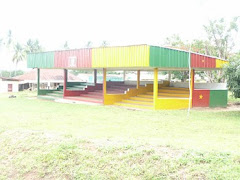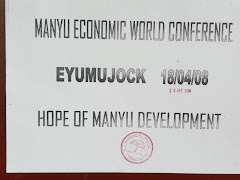 NEPAD, Africa’s development blueprint calls for countries in sub-sahara Africa to boost access to cheaper and reliable energy in order to achieve the desired social and economic prosperity for their nations. It is estimated that in some African countries, fewer than 5% have access to electricity with the figure falling to less than 2% in rural areas where the majority live.
NEPAD, Africa’s development blueprint calls for countries in sub-sahara Africa to boost access to cheaper and reliable energy in order to achieve the desired social and economic prosperity for their nations. It is estimated that in some African countries, fewer than 5% have access to electricity with the figure falling to less than 2% in rural areas where the majority live.Indeed, Africa posses some of the world’s largest watercourses –hydro potentials as well as worlds’ largest oil, coal and gas reserves. In order to move forward, African nations must find cheaper power sources to ensure sustainability and minimize environmental hazards. Experts believe that solar power, clean and renewable is the way forward for energy consumption in Africa.
Solar Technology
The sun is free, priceless and inexhaustible. Solar technology therefore converts the sun’s radiation directly into electricity with no pollution or harm to the environment. Solar panels generate enough power to run appliances such as televisions, radios, stoves, water pumps and produce light for households. Basically, the solar panel itself is a battery charger. When exposed to sunlight it produces direct current (DC).
 The solar charge controller regulates the amount of energy that the panels put into the battery. Once the battery is fully charged it opens the circuit to prevent damaged caused by overcharging. After using some of the stored energy, it automatically closes the circuit and starts to recharge the battery during sunlight hours. Solar panels are rated in watts. For example, a 12 volt 15 watt panel averages about 15 watts per hour of sunlight. Multiple panels can be wired together in most cases. Another component used with solar panel is the inverter. It converts 12 volt DC energy in the battery to standard 220 AC voltages found in homes in Africa. Finally, batteries used in Solar systems must be deep cycle types. A standard car battery will be damaged quickly. The two common types of batteries used in Solar are sealed lead acid deep cycle and standard marine.
The solar charge controller regulates the amount of energy that the panels put into the battery. Once the battery is fully charged it opens the circuit to prevent damaged caused by overcharging. After using some of the stored energy, it automatically closes the circuit and starts to recharge the battery during sunlight hours. Solar panels are rated in watts. For example, a 12 volt 15 watt panel averages about 15 watts per hour of sunlight. Multiple panels can be wired together in most cases. Another component used with solar panel is the inverter. It converts 12 volt DC energy in the battery to standard 220 AC voltages found in homes in Africa. Finally, batteries used in Solar systems must be deep cycle types. A standard car battery will be damaged quickly. The two common types of batteries used in Solar are sealed lead acid deep cycle and standard marine.Bringing Sun Power to Rural Manyu:
Solar panels mounted on the roof of a Village house.
 Although our people sometimes consume conventional modern energy, they do so in small amounts and pay dearly. Imagine dry cell batteries, they provide electricity but expensive. A candle or kerosene wick lamp does give light but a house will need much more to obtain same amount of light emitted by a single 40 watt incandescent lamp or 12 w compact fluorescent. Those who use candles and kerosene limit themselves to using enough light points to walk around the house. Hence the rural Manyu man has limited access to energy because of cost and accessibility. The levels of service our rural households enjoy now are only barely distinguished from that of medieval Europe. The Manyu rural household will never obtain a level of service, and improvement in social and economic conditions comparable to urban dwellers unless they get access to electricity - other than wood, dry cell batteries and biomass.
Although our people sometimes consume conventional modern energy, they do so in small amounts and pay dearly. Imagine dry cell batteries, they provide electricity but expensive. A candle or kerosene wick lamp does give light but a house will need much more to obtain same amount of light emitted by a single 40 watt incandescent lamp or 12 w compact fluorescent. Those who use candles and kerosene limit themselves to using enough light points to walk around the house. Hence the rural Manyu man has limited access to energy because of cost and accessibility. The levels of service our rural households enjoy now are only barely distinguished from that of medieval Europe. The Manyu rural household will never obtain a level of service, and improvement in social and economic conditions comparable to urban dwellers unless they get access to electricity - other than wood, dry cell batteries and biomass.
Future action:
For decades, kerosene lamps and sore eyes are the routine for children in Manyu villages to study and do their home work. Imagine painful eyes and headaches from fumes, not to mention the long term health impact of mothers cooking with firewood and inhaling smoke. How about impact on life span, aging and not living long enough to see their children grow? The Manyu land is blessed with plenty sunlight all year round. We can tap into this free and clean energy source to light up our remote and isolated villages that will never be linked to the national electricity grid. It can be done one house and one village at a time.
We owe it to our people, for economic prosperity and better living to explore the solar option. Bringing solar energy to a Manyu village is now conceivable than ever before. The average price of a one watt panel including electronics runs $7-$10 or 3500cfa - 5000CFA. With $500, we can light up a village hall.






































